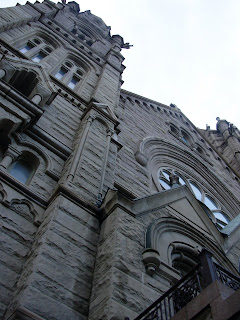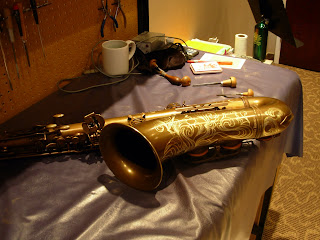 Yesterday morning after I'd finished my practicing (and had ended up mildly frustrated that I hadn't been able to get a whole lot done) I took a long walk along the Bonneville Shoreline Trail. It follows a bench formed by the ancient lake Bonneville (see previous post: May 2010, "Antelope Island") along the mountains of the Wasatch Front. Though only about 100 miles are officially designated today, the future proposed route would stretch 280 miles from the Idaho border in the north, to Nephi in the south. I only covered about 3 miles of it (6 miles out and back) from Sandy to Draper, but am now somewhat tempted by the idea of traveling a much longer portion at some point this summer.
Yesterday morning after I'd finished my practicing (and had ended up mildly frustrated that I hadn't been able to get a whole lot done) I took a long walk along the Bonneville Shoreline Trail. It follows a bench formed by the ancient lake Bonneville (see previous post: May 2010, "Antelope Island") along the mountains of the Wasatch Front. Though only about 100 miles are officially designated today, the future proposed route would stretch 280 miles from the Idaho border in the north, to Nephi in the south. I only covered about 3 miles of it (6 miles out and back) from Sandy to Draper, but am now somewhat tempted by the idea of traveling a much longer portion at some point this summer. In this photo it is easy to make out the trail snaking across one particularly wide section of the bench that may have once been a lovely beach. It's incredible to imagine the valley below filled with the deep waters of a vast inland sea--at one point much larger than any of the Great Lakes.
In this photo it is easy to make out the trail snaking across one particularly wide section of the bench that may have once been a lovely beach. It's incredible to imagine the valley below filled with the deep waters of a vast inland sea--at one point much larger than any of the Great Lakes.  I'd heard about this trail, but had never personally travelled it. It was a gorgeous Sunday--brilliantly sunny without being too hot and further cooled by a mild breeze--so of course the trail was somewhat peopled. It follows a moderately rolling contour with surrounding terrains ranging from wide flat sage brush plains, to moist shaded creek bottoms, to steep hillsides covered in thick scrub oak.
I'd heard about this trail, but had never personally travelled it. It was a gorgeous Sunday--brilliantly sunny without being too hot and further cooled by a mild breeze--so of course the trail was somewhat peopled. It follows a moderately rolling contour with surrounding terrains ranging from wide flat sage brush plains, to moist shaded creek bottoms, to steep hillsides covered in thick scrub oak.All along the way my eyes were constantly drawn to interesting sights large and small (particularly small). I noticed all sorts of tiny flowers I'd never seen before and caught glimpses of a great variety of birds and reptiles. Of course I had my camera out the entire time and had fun challenging myself to capture ever smaller blossoms and, commonly on this occasion, insects clinging to their fragile petals . These days, once I start taking pictures, I see more and more that grabs my attention and my habit snowballs until I'm stopping almost every few yards to capture images. This has the happy consequence of making me forget about what time it is or how far I've come, and allows me to become unselfconsciously lost inside a childish fascination with the world.
And because I took so many pictures and couldn't seem to narrow my favorites down any further, I'll just include them all today....
Here is a wild rose: the first, and largest, flower I photographed. It was one of my grandma Ricks' favorites. She had (maybe planted?) a huge bush of yellow wild roses in front of their house at the county line.

This one was really tiny! And I love the miniscule spines feathering out from its slender leaves. I wish I knew the names of these plants. I have a field guide at home--maybe I'll take it along next time.
Because of the particular way the petals of these flowers are structured (one large leaflet framed by two shorter and more slender ones), from a distance they looked like little five-sided snowflakes.


Here's one flower I know I hadn't ever seen before this hike, and I love it! it's like a miniature lilly pad, only it's growing out of the ground instead of floating atop a pond.

I think this bird is called a black-headed grosbeak. As you can see from it's confident pose and wide open craw, it was singing up a storm when I took the photo.
I was zooming in on this little purple flower when a fly unexpectedly landed right on top of it. At first I was annoyed and thought I'd wait till it flew away, but then I realized I'd gotten lucky and should instead try to get a shot of its feasting while I still had the chance!
The trail descended a couple of times to cross hidden mountain creeks. The water cascades through steep mini-canyons creating an occasional waterfall tucked into the mountainside almost out of sight.

Here's an area recovering after a wildfire. The snow-capped Oquirrhs line the horizon on the western side of the valley. The benches are easily set ablaze and all trails are marked with signs strongly prohibiting any open flame.
This shot took some courage on my part...for obvious reasons!
I was lucky to catch this little hummingbird taking a brief pause from its fast-paced search for food.

Normally I really dislike box elder bugs. I know they're basically harmless, but I am always a little creeped out when they fly at me or I find one crawling on the back of my shoulder. This one though is fairly photogenic--it's amazing how petty little phobias fall away when I'm behind the protective lens of a camera.
As the time for my departure to Evanston approaches, my interaction with everything here has taken on an increasing aura of farewell. Almost every day I recognize something else I'll miss when I leave Utah: maybe that's one reason for my new addiction to photography. It occurred to me as I was hiking yesterday that much of my attachment to the west, and Utah in particular, has its roots in my experiences out in nature. With so many incredible landscapes within reasonable traveling distance of Salt Lake, it's almost too easy to escape the bustle of daily life and surround yourself in wilderness.
I am excited to begin my studies at Northwestern and immerse myself in the rich and vibrant cultural community of Chicago, but I'll miss the special brand of solitude the mountains and deserts of Utah provide. Once I arrive in my new, if perhaps only temporary, midwest home, I'll have to make a concerted effort to get out and find the places nearby where I can get my required rations of natural beauty, peace, and fascinating wildness (like this miniature moss garden emerging from a crevice in a boulder). I'm also hoping those places won't be too overrun by gigantic mosquitos and wood ticks!
Until then, I plan to use this summer to its fullest potential and store up enough memories to help get me through my first winter in the windy city.










































